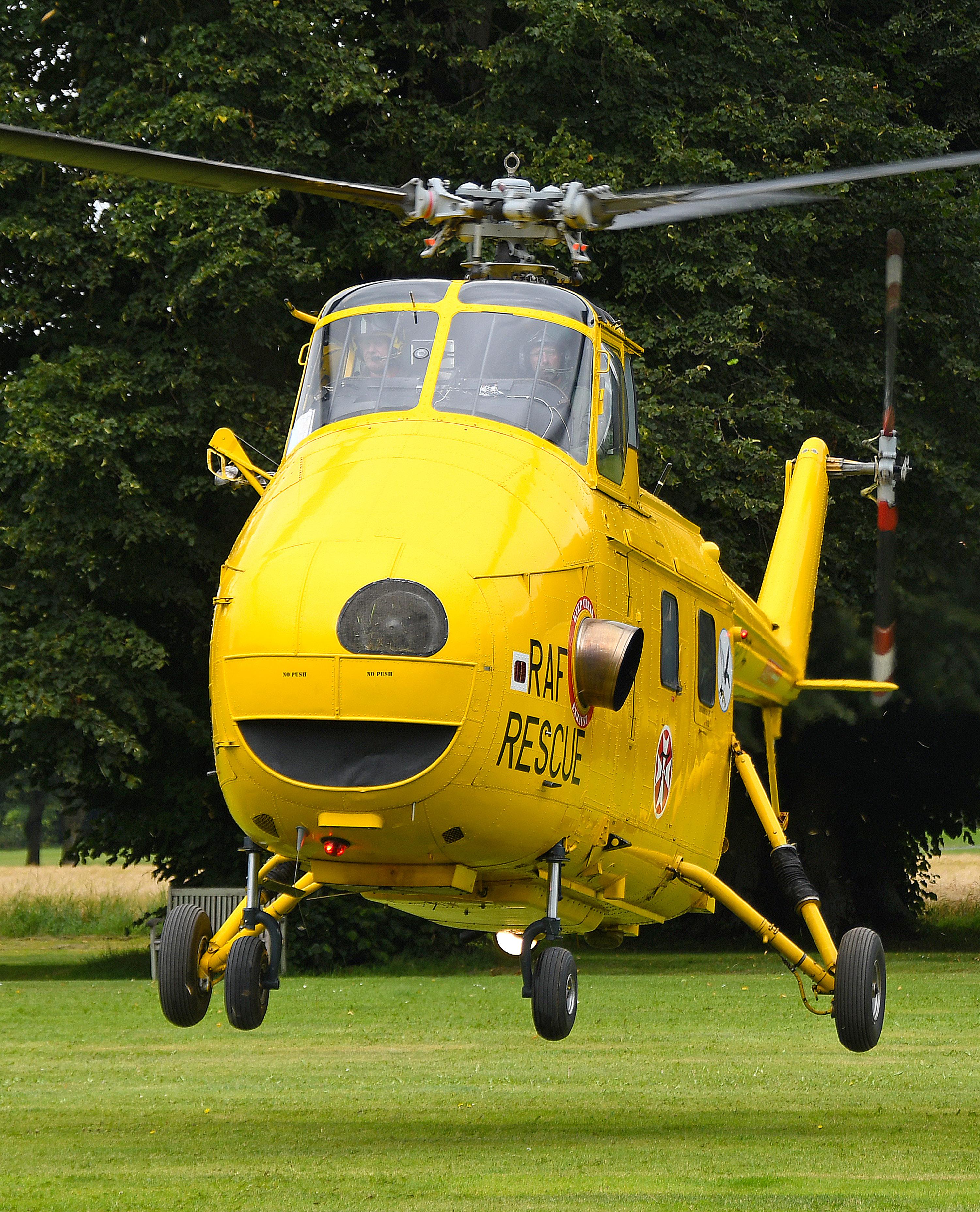
14 minute read
Historic Helicopters
RESTORATION | UK’s most historic helicopter collection
Historic Helicopters
Advertisement
As the saying goes, it takes a village to raise a child - and the same applies for getting a fleet of ex-military helicopters flying again. It’s certainly been a joint effort for the team at the unique aviation charity Historic Helicopters.
Rachel Ramsay reports…
As I turn off a narrow country road in Somerset and make my way down the drive of Chard Equestrian, I can’t help wondering whether I’ve come to the right place. That’s until I see something big and bright yellow in the yard. The unmistakable tail of a Sea King in RAF Search and Rescue livery.
It’s being washed down and that is no mean feat. Up close, Sea King 597 is colossal. Little wonder that they only manage to clean half of it in the time I’m there. I later spot the words ‘Rob’s best effort!’ scrawled into the dirt on the side they haven’t yet done. As I round the corner, I see that this mighty machine is sitting in front of an open hangar door, and I’m met with a sight that instantly tells me that Andrew has amassed a collection of helicopters most rotorheads can only dream of.
The bright yellow Whirlwind and red and blue Navy Wessex are the most immediately striking, and on closer inspection I spot another Sea King (this time a ‘Junglie’ in dark green; that’s the nickname for an ex-Commando Force Helicopter), a Wasp and a Lynx, which is being worked on by a couple of engineers.
The hangar is so jam-packed with rotary treasures that it’s some time before I notice that there’s also a Jet Ranger tucked in on the far side, dwarfed by the Wessex that it sits alongside.
I’m keen to find out more about how this unique collection came into being, and I take up a pew to talk with Andrew in the back of their ‘Junglie’ Sea King, which is awaiting its flight test. It all began, Andrew tells me, when he acquired a Westland Whirlwind, the only one of its kind still flying and quite possibly the oldest airworthy helicopter in the world.
Considering that this particular machine took its first flight all the way back in 1956, the Whirlwind is in remarkably good nick, its friendly ‘smile’ now as familiar a sight on the airshow circuit as it once was in service patrolling the beaches of Devon and Cornwall.
I’d first encountered it a couple of years ago at Weston-super-Mare Airshow, and had bumped into it again just a few weeks before at a vintage helicopter fly-in at Oaksey Park organised by Andrew Austen, whose father Brian is another big name in the world of historic helicopters. The Whirlwind’s hangar mate, the Navy Wessex, had also been at the fly-in, so I’d already had the privilege of seeing these remarkable machines in flight.
As a humble R44 pilot, I’m intrigued to know what it’s like to fly something as old as this – particularly given that Andrew’s more practical mode of transport is an Agusta 109.
“Did you find it an easy transition to start learning to fly these old machines after you’d been used to flying Jet Rangers and 109s?” I ask him.

Dave Wells (left) and Foz Foster (right), both ex-RAF, are full-time engineers at Historic Helicopters
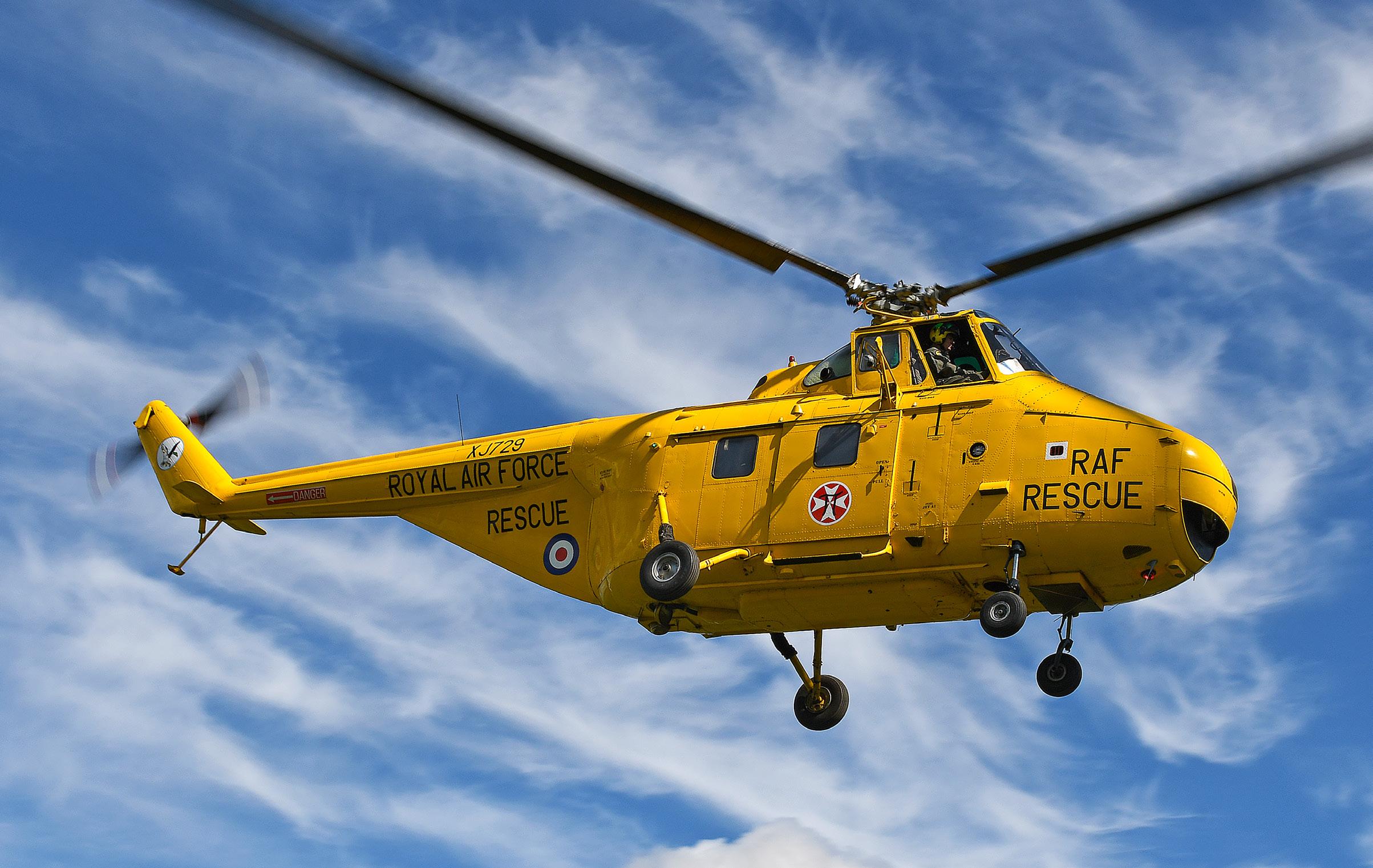
The Whirlwind in flight, once a familiar sight patrolling the beaches of Devon and Cornwall
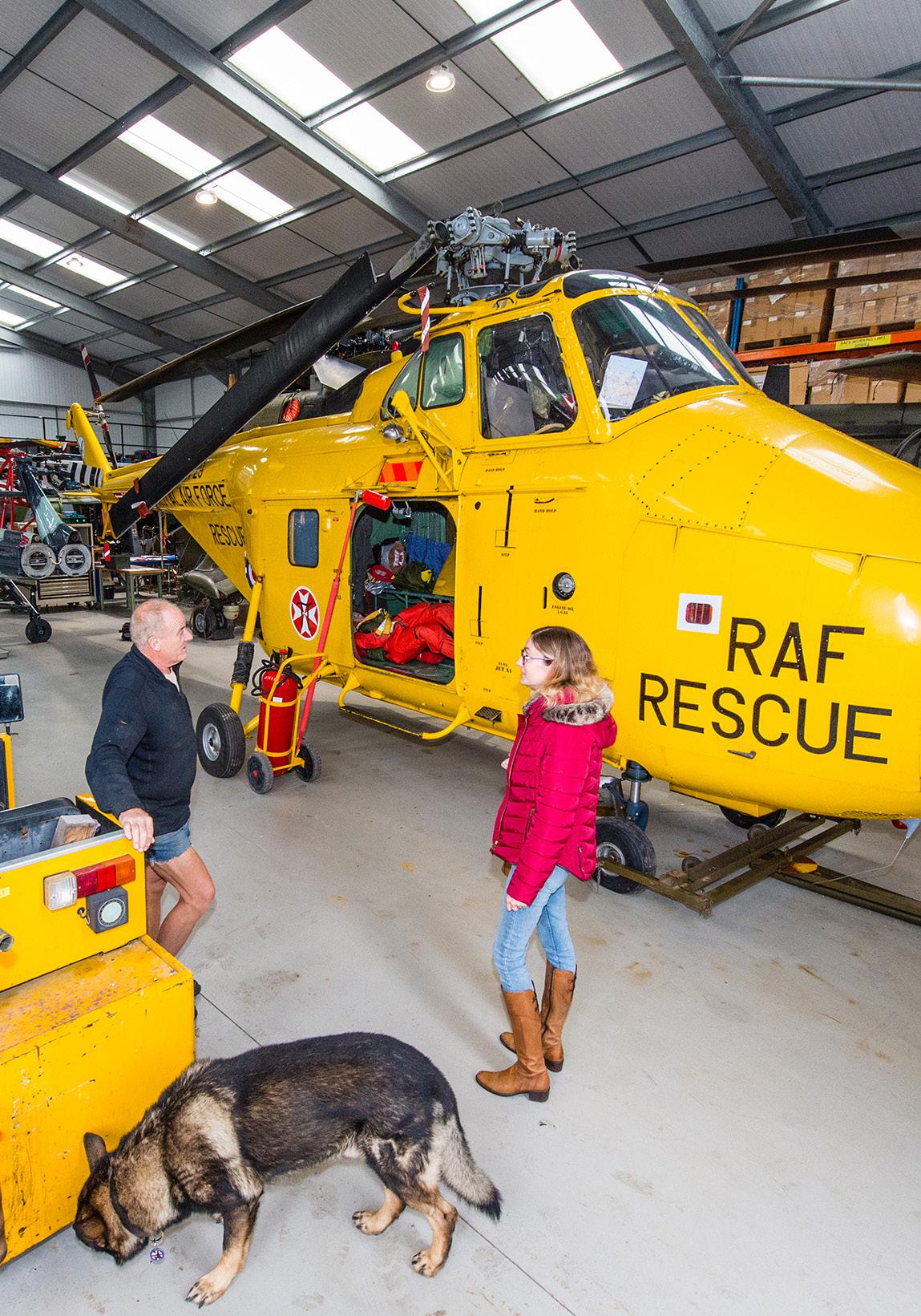
Rachel chats to Andrew alongside the Whirlwind, thought to be the oldest airworthy helicopter in the world
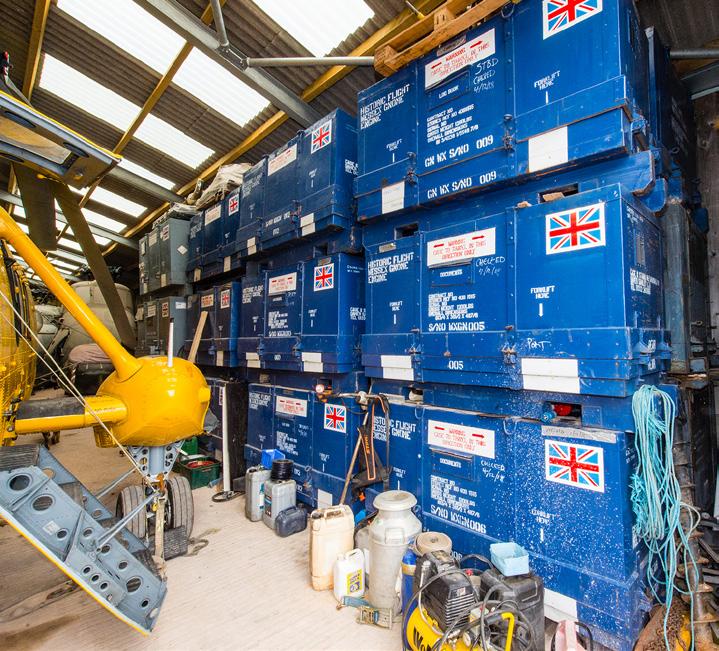
Spare Wessex engines, acquired in bulk from the MO
“Well, the Whirlwind is a different type of flying, and that’s the point with it,” he replies. “You don’t throw that thing around like you do with a 109. You don’t do the kind of things you do with a 109. You tend to fly it very carefully, very considered, watching the temperatures and the pressures all the time – one eye out and one eye in. You’ve got to be really careful with it, because it is the only one – and the same with the Wessex. We’re over-cautious probably – a progressive, cautious approach to everything we do.”
And, of course, it’s a manual throttle, something that will be familiar to anyone who’s ever been fortunate enough to fly that other iconic vintage helicopter, the Bell 47. “It’s a totally different approach to flying the Whirlwind,” Andrew continues. “Because I was the only Whirlwind pilot type rated in the world – there was nobody else – the CAA gave me dispensation to train Steve,” he says, referring to Chief Pilot Steve Daniels, whom he describes as ‘probably one of the best helicopter pilots in the world’.
“So I’m now no longer the only Whirlwind pilot, which is sad in some ways, good in others!”
I put to Andrew that it’s an exclusive group.
“Yeah, it is. We’re quite fond of the Whirlwind and I’m not going to let just anyone fly it.”
One person who certainly isn’t ‘just anyone’ is Andrew’s partner Jane Gregory, who’s currently converting to the Sea King. She tells me she’s the only woman flying an Agusta 109 on a PPL.
“I’m probably the only girl who’s got the opportunity to fly the Sea King, if we’re honest,” she admits when I quiz her about how she’s finding the training. “Of all the helicopters in there, this is the one I like the best. The Whirlwind is single engine, there’s only one in the world, and Andrew flies it. She is so old, I’d be too scared to fly it. If something went wrong… The Wessex is twin engine but officially it’s single pilot – and there’s only one of those too. There are more of these (Sea Kings), which means you don’t have that same pressure on you. And it’s twin pilot, and I think doing the whole female crew thing is going to be amazing.”
She’s referring to the fact that she and ex-Search and Rescue pilot Ayla Holdom are planning to fly the Sea King together with a female support crew member, forming an all-female flight demonstration team for next season’s airshows.
Indeed, I get the impression that the Historic Helicopters team is incredibly supportive of female pilots, with a scholarship underway to fund one lucky pilot through her CPL training. It’s always good to see female pilots, I remark to Andrew.
“Abso-bloody-lutely!” he replies.
I get the chance to see Jane in action as she takes to the righthand seat of the Sea King to fire her up and perform a blade fold, as engineer Dave Wells reads out the items on an exhaustive checklist covering each of the bewildering array of buttons and switches in the cockpit.
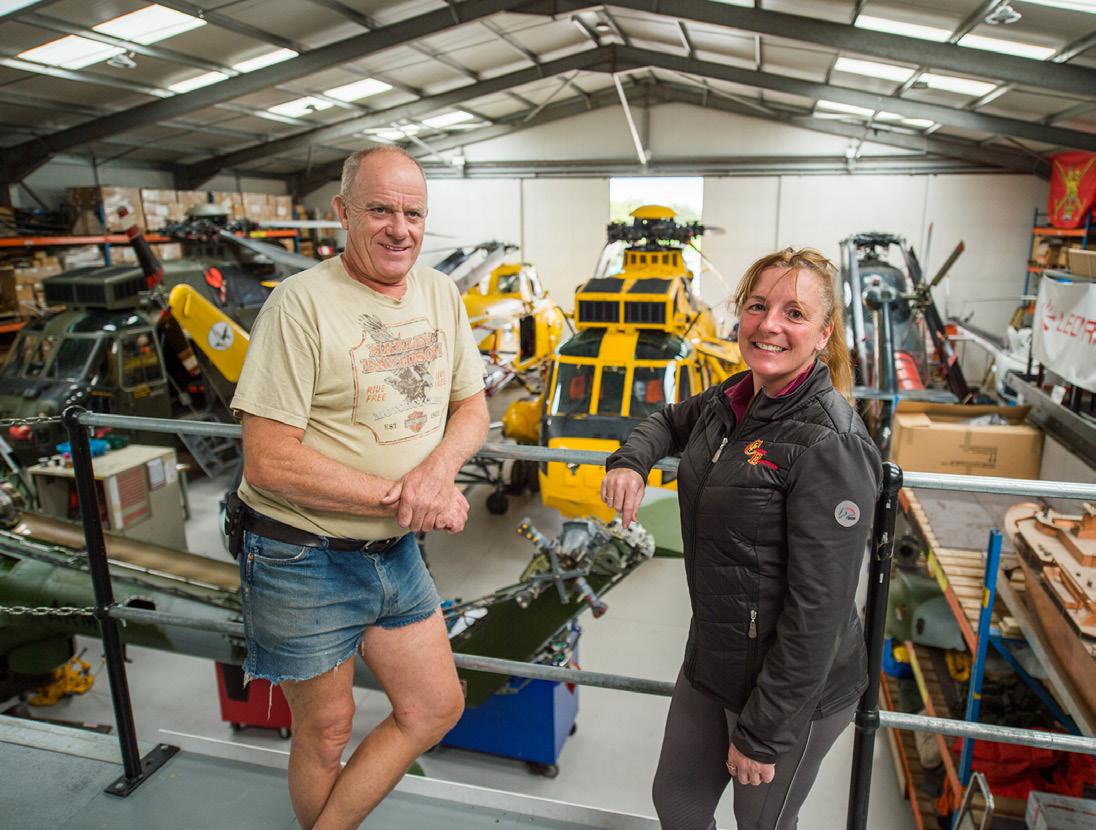
Andrew Whitehouse and Jane Gregory in the hangar of rotorhead dreams
Intricate folding process
The Sea King performs the intricate folding process automatically, with the rotors inching round to line up with the tail – drooping almost to the ground as they do – and the tail rotor folding back to make it easier to store on ships or in hangars.
With Sea King 597 safely back in the hangar – a Tetris-style undertaking that involves rotor blades fitting in millimetres from fork lift trucks – I get chatting to Dave. He and fellow full-time engineer Foz Foster are both ex-RAF, and first worked together in the early 1990s. Dave tells me he met Andrew while working as Crew Chief at Chivenor, when Andrew had flown the Whirlwind into a 22 Squadron reunion. This chance meeting ultimately led to Dave working full time at Historic Helicopters, and he’s uniquely well-placed to be working on this collection, with some lively stories to share about his years working on Sea Kings.

The Sea King’s cockpit is a bewildering array of buttons and switches
He tells me about the time when he was down in the Falklands in 2003 and a Sea King had been brought over on an Antonov, nose to nose with a Tornado. During the unloading process the Tornado had become loose and put a hole in the nose of the Sea King. They worked through the night to get it ready to fly the next day, signing their names behind the makeshift panel they’d fitted, and then he ‘forgot all about it’.
He brings the story vividly to life when he lifts open the avionics bay at the front of the Sea King we’re standing next to, shining his torch inside and beckoning me over to inspect what’s behind the front panel: those very signatures. I can only imagine the amazement he must have felt to be reunited with the aircraft he’d worked on under such different circumstances.
With the collection flying a low number of hours each year, and in a set-up that Andrew acknowledges is something of a labour of love, there isn’t the time pressure the engineers knew when they were up against the constraints of life in the forces. “We get time to do everything exactly right, so when they’re done they’re as good as we can make them,” says Dave. “And this is a well-resourced operation, not just a guy on a shoestring.”
The engineers dig out an interesting entry in 597’s log book to show me. ‘Pilot: Wales’ – none other than Prince William himself. But the days of being flown by the heir to the throne are long gone for 597, and it’s now earning its keep in a more sedate fashion.
The airshow circuit forms a source of income for Historic Helicopters; nowhere near enough to break even, of course, but every little helps when you’re operating machines that can burn up to 1,200lb of Jet A1 an hour.
Income stream
And that’s not the only world that Andrew’s machines are becoming known in: film and television has provided another valuable income stream for the collection. An airworthy vintage helicopter is a handy asset for that touch of authentic detail in productions set a few decades ago, and although Sea King 597 only took the first flight of its new life earlier this year, it’s already been in demand from production companies. In fact, on the day of my visit the team had just returned from a few days of filming with it in Scotland, and I imagine the heads that it must have turned as it transited up the country.
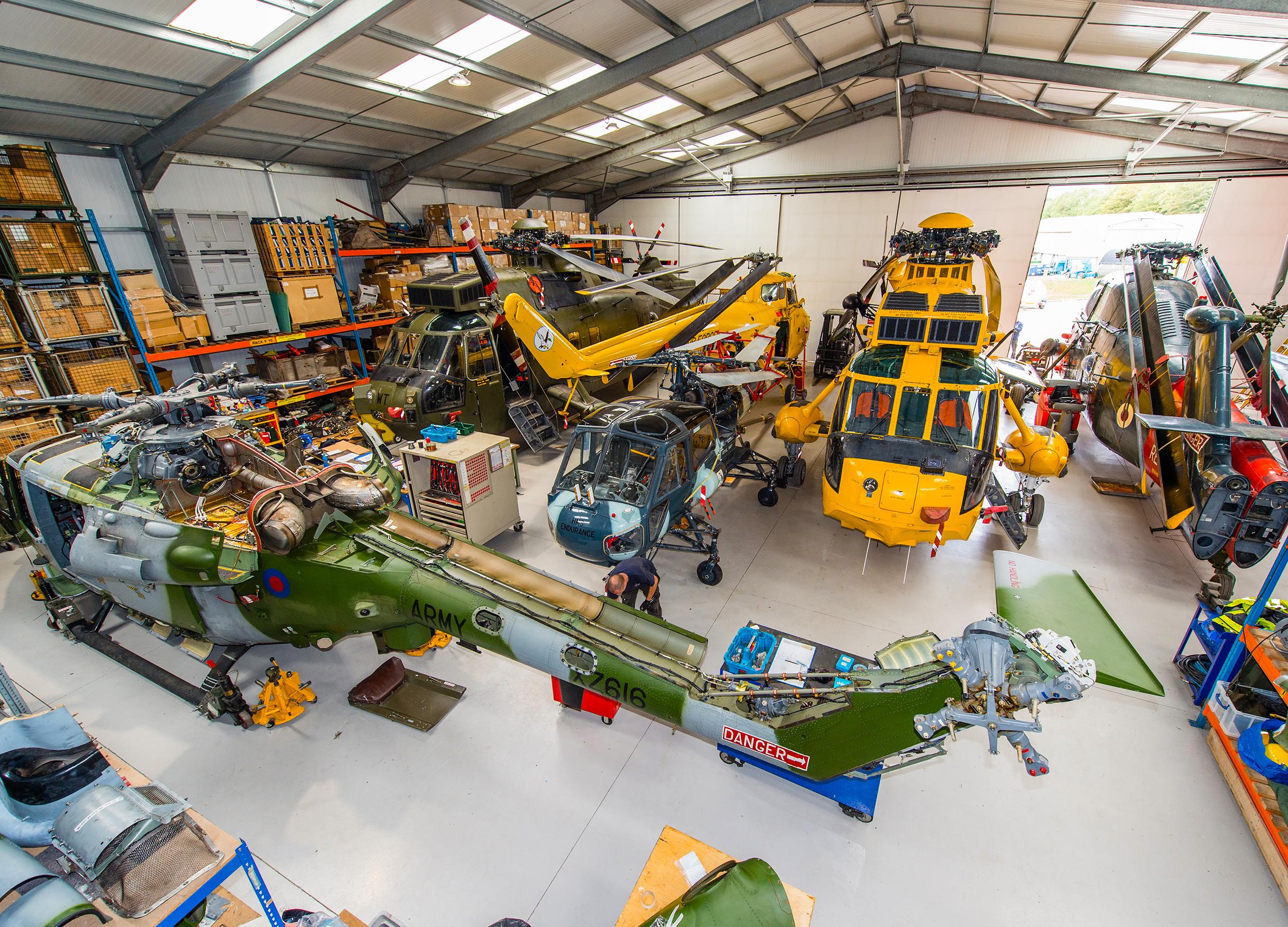
How many historic helicopters can you fit in one hangar?
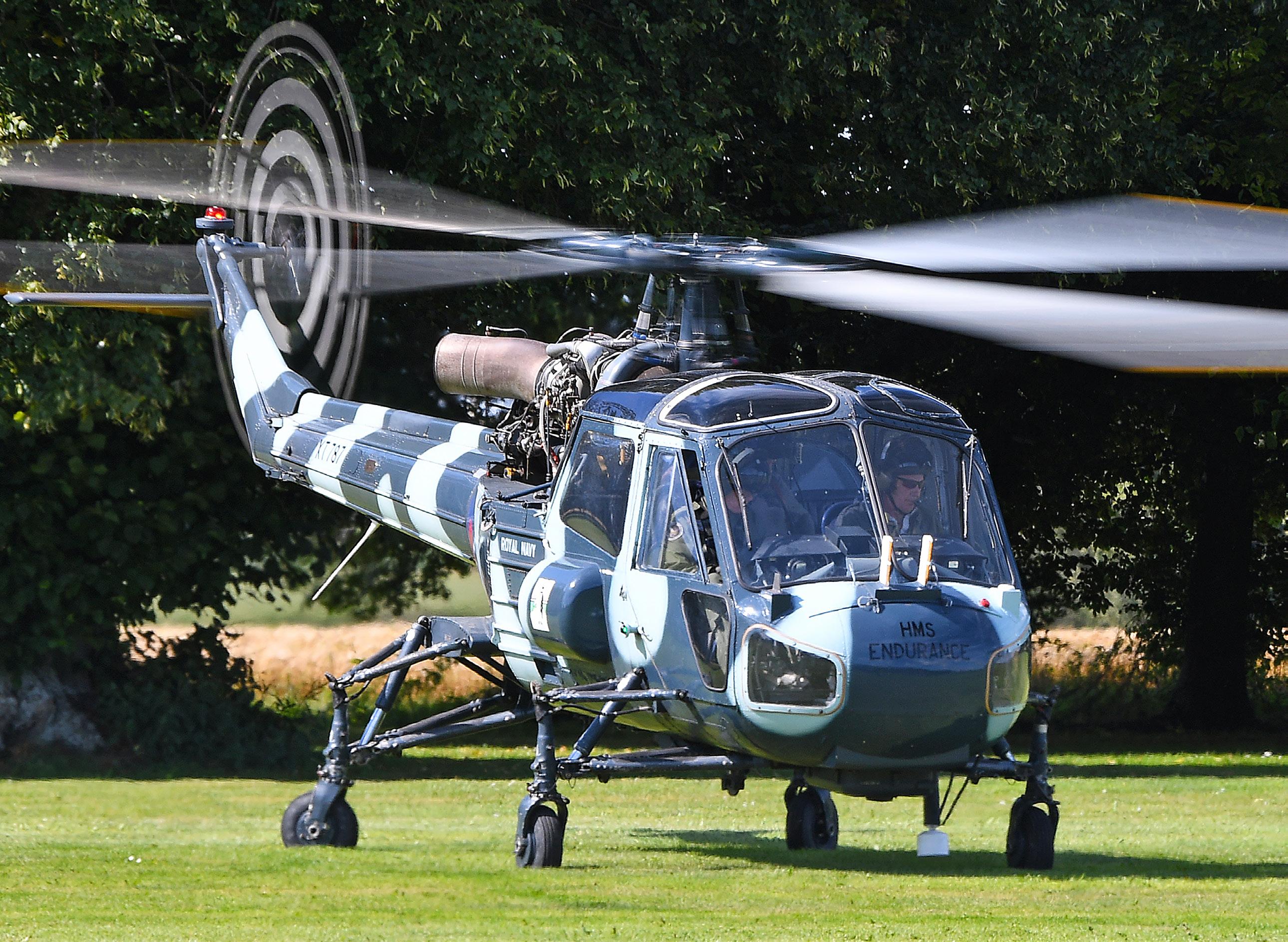
Historic Helicopters Westland Wasp at the vintage helicopter fly-in at Oaksey Park in August

When you’re packing the Sea King into the hangar, it helps to know where to stop…
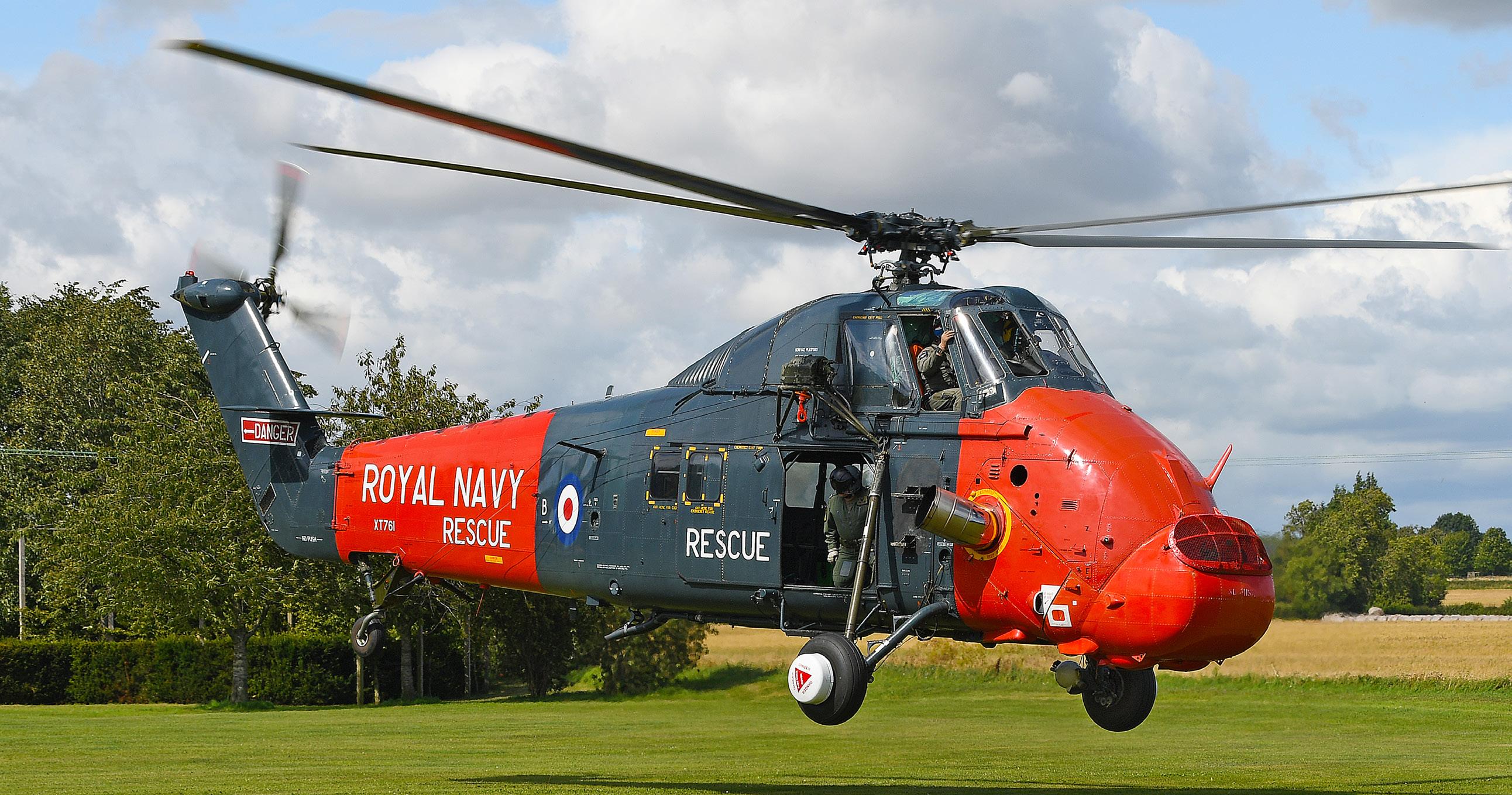
The striking Navy Wessex lifting off at Oaksey Park
Before I leave, I discover that the hangar I’ve spent the last couple of hours looking around is only part of the collection. Andrew takes me over to a second barn across the yard, where I’m astonished to see another Sea King and two more Wessexes. Not only that, but stacked up along the one side of the wall are crate upon crate of Wessex engines, acquired in bulk from the MOD. Andrew tells me that it takes the team a week of each year to unbox and turn them over to keep them in condition.
Clambering on board the third Sea King, I’m met with a sight unchanged since it was in active service. The radar operator’s station is still in situ, as is the ‘wet fit’ flooring to prevent seawater (and blood) from spreading through the helicopter during a rescue.
There’s even the boiling water tap for the crew to make a brew. It’s a reminder that all the machines in this remarkable collection were once true military workhorses – and, like every good workhorse deserves, they’re being well looked after in their retirement. Put out to pasture in the idyllic surroundings of this unique equestrian/helicopter paradise, they really couldn’t have asked for a better place to adjust to civvy life.
To find out more about Historic Helicopters, go to https://www.historichelicopters.com where you can sign up to become a member for exclusive monthly content, hangar tours and more.
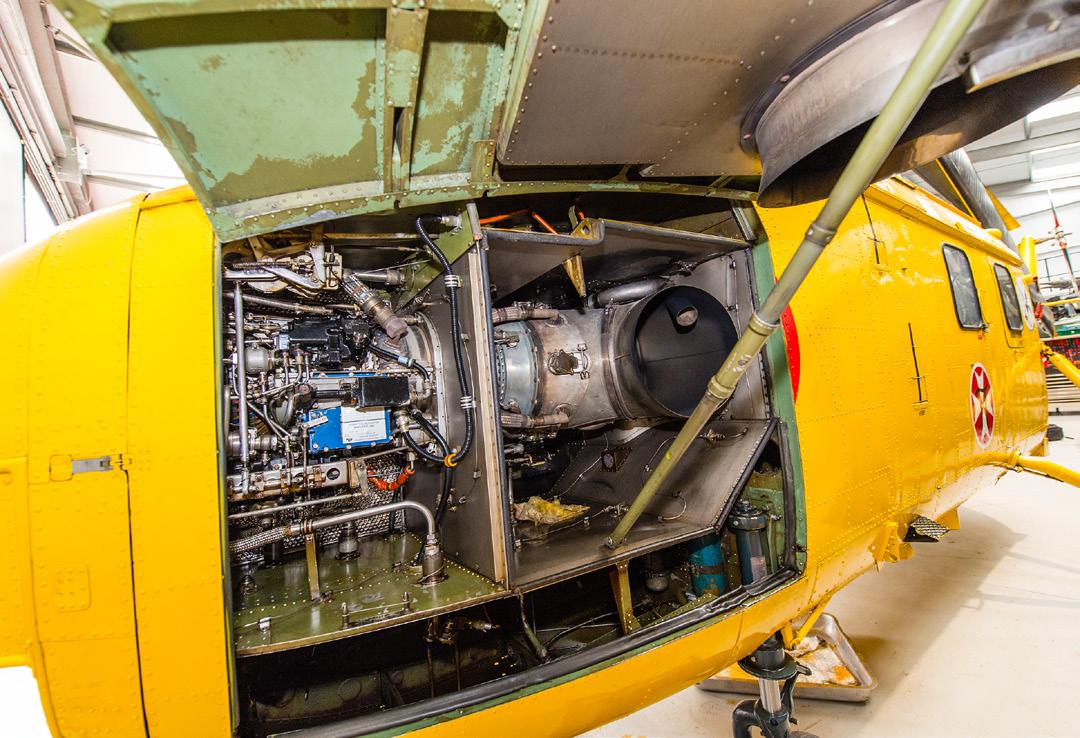
The Whirlwind’s single Gnome turbine has been upgraded to a more powerful model, but de-rated
Want to log some hours in an ex-military helicopter?
The Sea King, Whirlwind and Wessex might be off limits to all but a select few, but if you’re keen to log some time on a Westland, you could soon be in luck. Helicopter instructor and examiner Mark Cowley recently replaced his R44 with a Scout and plans to offer Scout and Wasp type rating courses, as well as mini courses for enthusiastic PPL(H) holders who want to see what it’s like to take the controls of these legendary machines.
“I particularly like the Westland Scout and the Wasp, as they are such iconic British-made helicopters and hark back to a golden age of military flying in the 1960s, 1970s and 1980s,” says Mark. “They are solid, heavy and built to withstand the rigours of the battlefield or a harsh marine environment.”
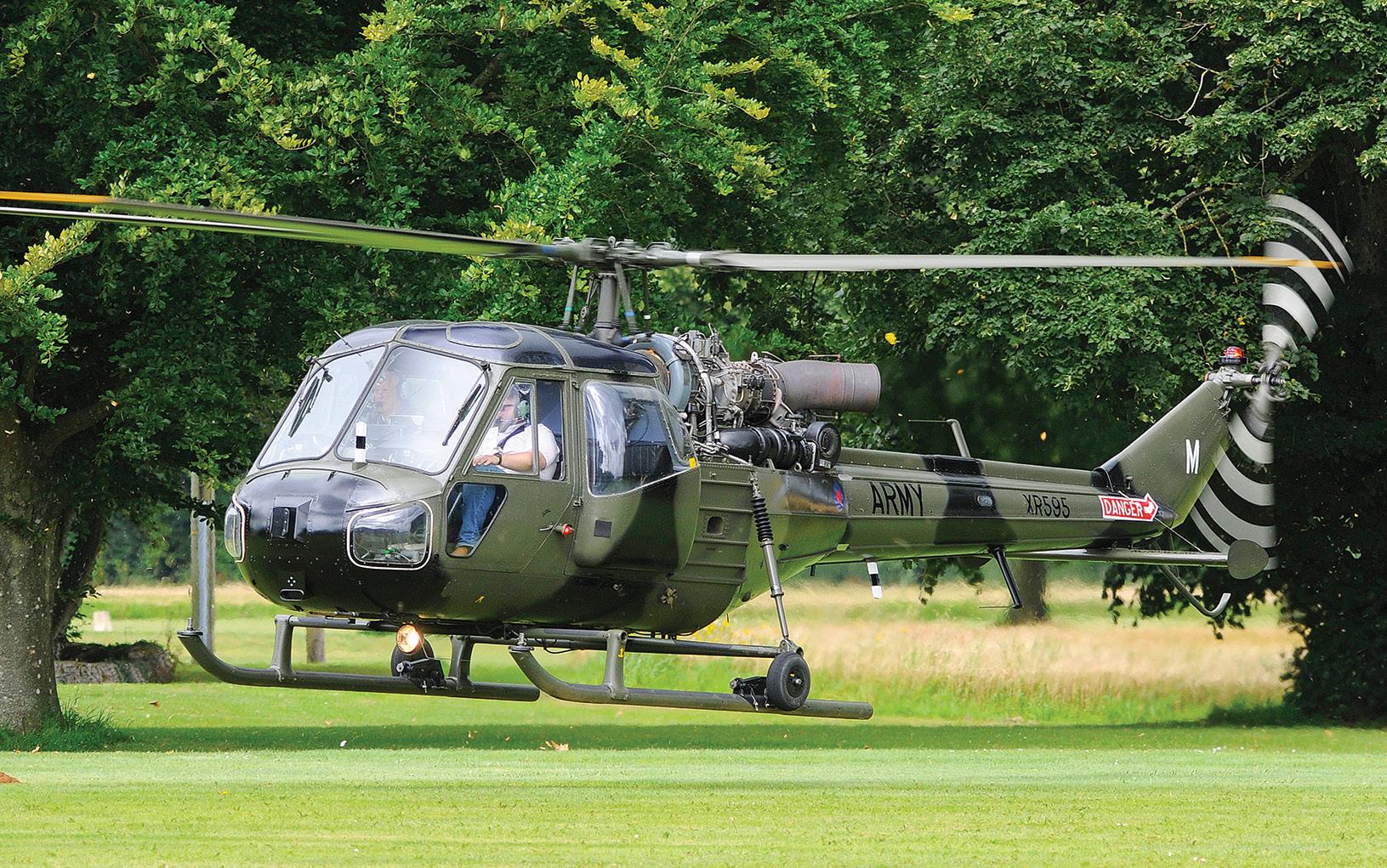
So what’s it like to climb on board? “When you first get in the Scout, you immediately notice that it smells distinctively of leather and oil, like a classic vintage car,” Mark explains. “You look around at all the switches and circuit breakers and they are captioned ‘Rockets, Slow Falling Flares, Guns, Missiles’, etc – it really does capture your imagination. They are classic military aircraft, purpose-built for the job they were required to carry out in the armed forces.”
Is the Scout difficult to fly? “Not particularly, but it does have quirks that will cause an inexperienced pilot a problem unless you have some reasonable helicopter experience,” says Mark. “As an instructor, I think it is sensible that you cannot generally learn to fly in one if you have not got a PPL(H). I don’t relish the thought of trying to teach someone to hover in one.”
Even as an existing PPL(H) holder, it’ll take you more hours to achieve a type rating on a Scout than on most helicopters – it’s a 10-hour course, compared with five hours for most ratings. At the time of writing, Mark is awaiting approval from the CAA for his new Scout/Wasp type rating training manual, which he’s adapted from an original manual to be more suitable for civilian instructors. He’s had to ensure that the syllabus covers aspects civilian pilots won’t be familiar with, such as the dangers of misinterpreting old military instrumentation.
When the training manual is approved, Mark’s courses promise to be a fascinating insight into military helicopter flying as well as an enjoyable flying challenge. Students will hear from senior ex-military pilots, who’ll come along and lecture on the history of the helicopters, their development in service and the role they played in the armed services around the world.
The final details are still being worked out, but if you’re interested in being kept in the loop for the chance to log some time on a Scout, Mark will be operating through his company Dragonfly Aviation, and you can contact him for more information at dragonflyaviation@btinternet.com
Westlands galore at Oaksey Park
If you had gone down to Oaksey Park Airfield in late summer, you’d have been in for a big surprise. Seldom does one see a solitary Westland Wasp, let alone a whole line-up of Wasps and Scouts, joined by Andrew Whitehouse’s Navy Wessex and Whirlwind, with a Gazelle and Alouette thrown in for good measure. This unusual gathering was organised by airfield operator Andrew Austen, who told me that if it wasn’t for his father Brian – formerly a purveyor of historic helicopters – there would probably be very few of these machines still flying.
“I had recently become reacquainted with both dad’s Whirlwind and one of his Scouts, so a vintage helicopter fly-in seemed like a great idea,” he explains. “What really pushed me on was the idea that by bringing the current generation of owners together, we could help keep these fantastic machines going for a little longer through a sharing of knowledge and passion for a part of aviation I rather think gets forgotten about.” D
espite the need to limit visitor numbers due to Covid restrictions, the day was a resounding success, with flight crews enjoying a sumptuous barbecue and cake courtesy of the Austens, and a small bevy of photographers to capture the occasion.
“I’m really pleased with how everything went,” says Andrew. “Maybe it’s just me, but the event does seem to have sparked a little flame in the heart of vintage helicopter flying that was little more than an ember in previous months. Hopefully we have reinvigorated this small but important corner of our sport for many years to come.”

Ancient and modern: the Wiltshire Air Ambulance also dropped in

The unmistakable livery of the RAF Search and Rescue Whirlwind turning heads at Oaksey Park









